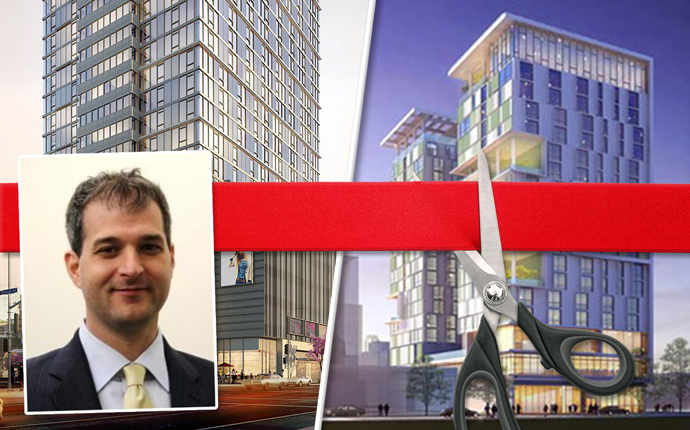Trending
Roll up the red tape: LA developers eye exemptions for CEQA salvation
Sustainable Communities programs can provide a path through environmental bureaucracy for builders, but challenges remain

More than a decade ago, California instituted two statewide initiatives to exempt and streamline environmental compliance for transit-adjacent residential developments.
The clearance programs associated with the California Environmental Quality Act (CEQA) are now beginning to be implemented in Los Angeles County, where developers and environmental activists routinely battle over real estate projects seeking to comply with the state law.
Both programs stem from Senate Bill 375, a California law passed in 2008 and designed to reduce greenhouse gas emissions through regionally focused strategies. It took the Southern California Association of Governments more than a decade to develop those protocols and obtain certain state approvals, but now Sustainable Communities are finally starting to emerge in Los Angeles.
Experts claim the designations — known as the Sustainable Communities Environmental Assessment (SCEA) and the Sustainable Communities Project CEQA Exemption (SCPE) — may save proposed residential projects months of time normally lost during the environmental review process.
Despite some flaws, Los Angeles developers who for years have looked for a way around often-costly environmental reviews are now taking up Sustainable Communities clearance programs.
“We’re going to be seeing a lot more of these,” said Dave Rand, a land use expert and partner at the Westside-based law firm Armbruster Goldsmith & Delvac. “I’m strongly encouraging my clients to take these approaches wherever I think they are possible and politically feasible, because I know the pain of my multifamily clients waiting two years for an [environmental impact report].”
A slow embrace
Perhaps wary of the inherent unknowns associated with any new review process, developers in Los Angeles have been somewhat slow to go all in on Sustainable Communities. So far the city has approved roughly a half-dozen SCPE applications and fewer SCEAs.
There are now four SCEA projects and two SCPE projects pending approval. Among the applicants now seeking to utilize the clearance programs are local firms GPI Companies and Thomas Safran & Associates, as well as the Vancouver-based Onni Group. All three outfits did not return requests for comment by the time of this story.
SCEA qualification is less stringent than SCPE, and thus more broadly applicable across Los Angeles. But SCEA does not entirely bypass CEQA, serving instead as a more legally watertight assessment to cut down on lengthy court challenges to SCEA projects. SCPE does sidestep CEQA, so long as a project meets certain criteria.
Chris Joseph, a planning consultant and owner of Los Angeles-based CAJA Environmental Services, said he expects the relatively small number of SCEA and SCPE applications to pick up as the city approves more projects. CAJA itself is benefiting from an uptick in activity, working on five separate projects seeking to qualify for either SCEA or SCPE.
“Everything is so relatively new,” Joseph said. “Most [consultants] are working on at least one.”
Separating SCEA and SCPE
While SCEA does offer legal advantages to the traditional planning process, CEQA exemptions through SCPE make them the more enticing of the two options available to Los Angeles developers.
The SCPE process can be rigorous, but less so than the CEQA process. A report on the exemption that Los Angeles granted for GPI’s 26-story, mixed-use project at the Amoeba Records site in Hollywood spans 5,500 pages.
Projects are eligible for a SCPE designation if they are built near mass transit, have less than 200 units, designate between 5 and 20 percent of their units for affordable housing — the percentage is dependent upon the level of affordability — and have half of their square footage zoned for residential.
Other requirements include an eight-acre limit on the project site and open space conditions based on project density. Regardless of all that red tape, Rand said SCPE’s scrupulous reviews are still preferable to a full CEQA report.
“It’s a very powerful tool,” he said. “If you can make those findings you don’t have to do any noise traffic or air quality impact analysis, you just have to show you have to meet statutory criteria.”
An opaque outlook
Both SCEA and SCPE still have kinks that must be worked out in order for developers to rely upon them in doing deals.
Other development-friendly programs in Los Angeles such as Transit Oriented Communities only require approval from the City Planning Commission. A quirk in California’s SB 375, however, means the full City Council must grant its approval for projects to clear both SCEA and SCPE.
Rand, the real estate lawyer, said the approval process from the City Council is far less efficient than that of the planning commission. In early 2018, Councilmember Jose Huizar sought to delegate SCEA and SCPE approval power to the planning commission, but the proposed ordinance that would implement such a change hasn’t moved since October.
California would also have to amend SB 375 to permit the delegation of a full CEQA exemption through SCPE to the local planning commission, another tall regulatory order.
As with any new law or policy, there are also gray areas that need to be sorted out in court or through the municipal appeal process. A judge upheld a SCEA approval for a mixed-use project from Houston-based developer Camden USA in the Arts District, although the entitlements for that project were rescinded for other reasons. Developers working in other parts of California have had success in court defending SCEA applications, but questions remain as to how challenges to them will be adjudicated and resolved.
“There’s a whole basket of arguments on SCEA and the exemption,” Rand said. “Ultimately, those will be vetted by courts and we’ll have more clarity. That’s not stopping me from recommending the use of these tools where they apply.”
An affordable look forward
The risks of going down the unbeaten paths of SCEA and SCPE might keep some developers away, but if early adopters have success, Los Angeles could see a spike in applications for Sustainable Communities programs.
Weingart Center Association, a nonprofit homeless social services agency serving Los Angeles, is currently seeking SCEA approval for a 298-unit, mixed-use affordable housing project near Skid Row.
Kevin Murray, a former state senator and assemblyman who now serves as president and CEO of Weingart, said there was a “little bit of risk” involved in pursuing a SCEA designation, but hardly more than a normal environmental review.
At the same time, he cautioned that Sustainable Communities programs are not a panacea for stalled projects or a guaranteed end-around to potential environmental challenges.
“The reality with these projects is that if someone is opposed enough to sue, it’s still going to hold up a project,” Murray said. “It’s not a ‘get out of jail free and bypass any process’ card.”




